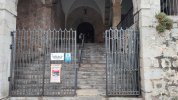simoneva
New Member
- Time of past OR future Camino
- frances (2016)
norte/primitivo (2017)
aragon/frances/salvador/norte (2018)
frances (2019)
Stayed at casa de Trinidad convent in Laredo. Good albergue with most rooms only 2 or 3 beds but....they have a 10pm curfew. Most restaurants don't open until 9pm so it is a bit rushed.
Four of us got back from food and beer at 2245. The cunning plan was another pilgrim inside ready to open the door. Unfortunately they actually lock the gate with a padlock!
In this case 3 pilgrims scaled the 3m fence. I could not but fortunately found a spare bed. So in this case just another story from the Camino
However it might not be a happy ending. Seems a bit unsafe to lock people in if you needed an ambulance or to escape a fire. Do they not have regulations in Spain?

Four of us got back from food and beer at 2245. The cunning plan was another pilgrim inside ready to open the door. Unfortunately they actually lock the gate with a padlock!
In this case 3 pilgrims scaled the 3m fence. I could not but fortunately found a spare bed. So in this case just another story from the Camino
However it might not be a happy ending. Seems a bit unsafe to lock people in if you needed an ambulance or to escape a fire. Do they not have regulations in Spain?



























